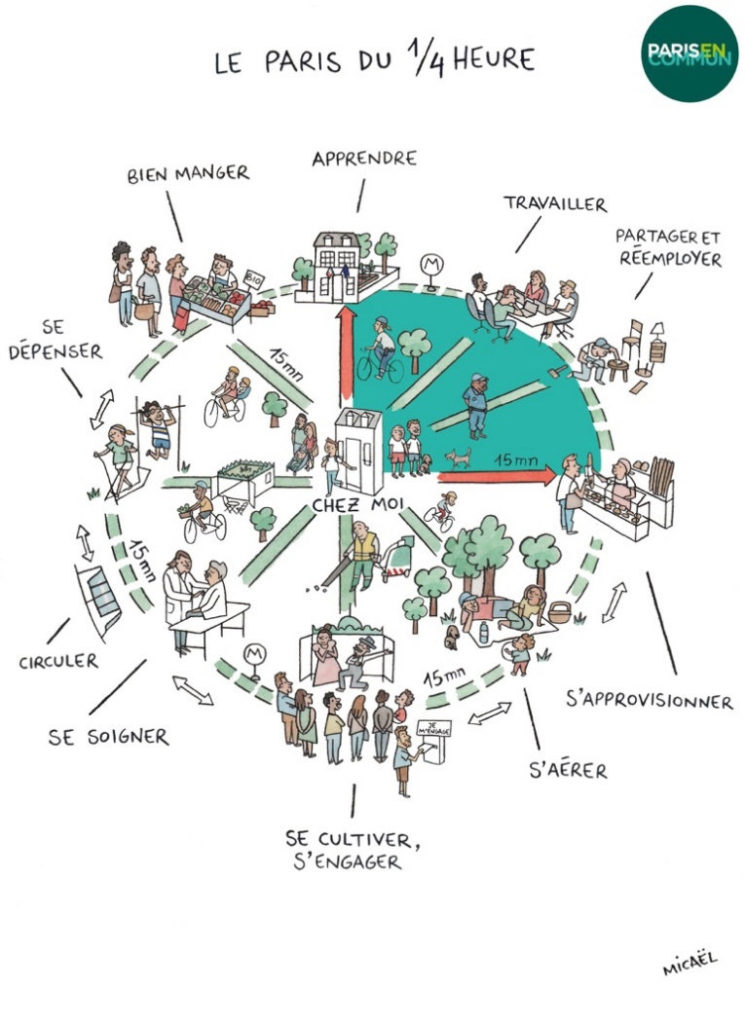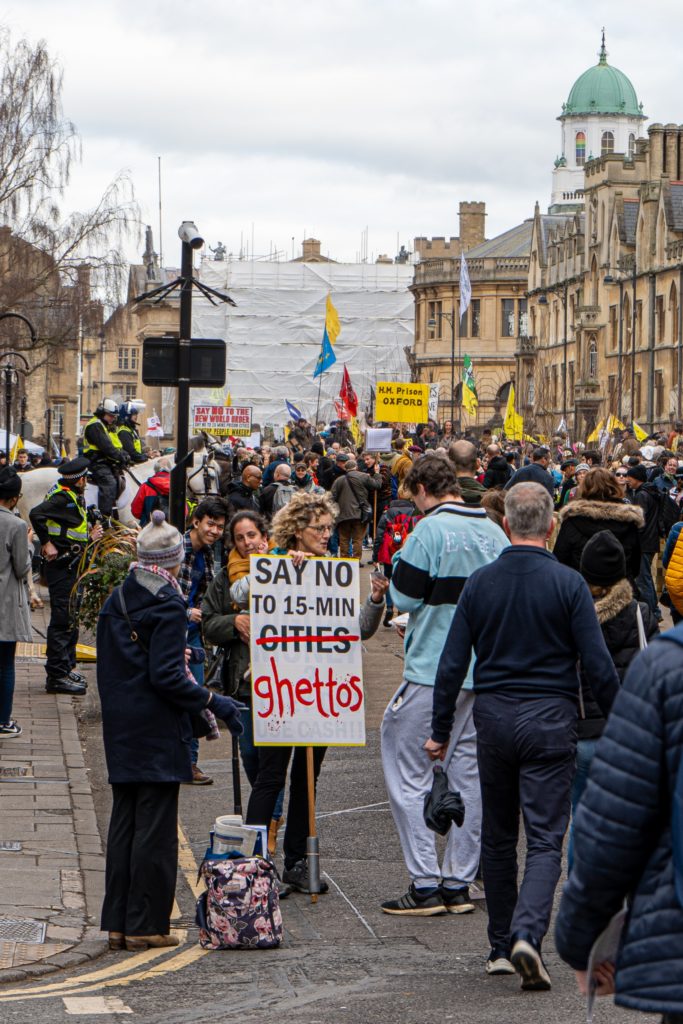‘I would like to offer a concept of cities that goes in the opposite direction to modern urbanism, an attempt at converging life into a human-sized space rather than fracturing it into inhuman bigness and then forcing us to adapt. I call it ‘the 15-minute city.’
Carlos Moreno, urban planner, pioneer of the 15-Minute City model
The 15-minute City model has been the talk of the post-pandemic town…or shall I say city, as it prioritizes both livability and climate resilience, unlike the current urban planning model (think city grid, cars, pollution, and sprawl). The 15-Minute City is a decentralized city in which the inhabitants are able to access all of the services and amenities necessary for living, working, commerce, healthcare, education and entertainment, within a fifteen minute radius by foot or bike. Urbanist Carlos Moreno, who theorized the concept in 2016, argues in the TED Talk below that the human scale of the model not only improves quality of life because commuting is removed from the urban experience, but also promotes community bonding, participation, and a stronger sense of place within each 15-minute neighborhood.

The shift to the virtual working model during the pandemic made the dysfunctional planning of urban neighbourhoods difficult for policymakers to look past, including the lack of public space to sustain community, as well as the lack of access to essential services locally. The 15-Minute City concept was first adopted by the mayor of Paris, Anne Hidalgo, during her 2020 reelection campaign. Although the “Paris en Commun” plan is in its early stages of implementation, its pedestrian-centric interventions have garnered much attention, and other cities have begun to plan their own versions of the model, including Barcelona, Spain, Melbourne, Australia, and Portland, Oregon.
The sustainability of cities has been a hot topic in international dialogues, including COP26, and has its own dedicated Sustainable Development Goal due to the urgent need for decarbonization strategies. Not only do cities produce 60% of greenhouse gasses, but they themselves have begun to deteriorate under the pressure of rapid urbanization due to climate migration. Automobiles, which the grid city plan was designed to accommodate, account for 78% of urban emissions. Thus, to be viable, an urban plan must reduce vehicle reliance while also promoting an alternative mechanism of accessibility for city dwellers. The 15-Minute City, constituted by the four core principles of proximity, density, diversity, and digitalization, aims to complete this two-part assignment by restructuring neighborhood units to be more sustainable, livable, equitable, and convenient. Since the utility of the 15-Minute City, if successful, is self-evident in the diagram above, I aim to analyze the four core dimensions of the model with a critical eye. Is a peaceful and prosperous city – made up of self-sufficient, miniature utopias – too good to be true?
Proximity
The 15-Minute City concept is increasingly reduced to its proximity dimension, due to its potent imagery being co-opted by commercial developers. It is convenience to urban amenities, above all else, that is championed in their master plans for futuristic, ‘green’ cities. It is easier to design a 15-Minute City when planning from scratch. But how can you restructure existing cities so that a person can get to their place of work (perhaps at their dining room table), a doctor’s appointment, their child’s school, the gym, the post office, the grocery store, and the movie theater, by walking within a fifteen minute radius? Carlos Moreno (speaking in the TED talk cited above) thinks proximity is so important in urban planning because people’s quality of life is negatively impacted by commuting, and commuting, specifically by car, has a big environmental footprint. If everything an individual needs is located within their 15-Minute neighborhood both of these issues are solved.
But, what if people don’t want their urban experience reduced to only their immediate surroundings? Urbanist Alain Bertaud points out that the trade-offs people make when deciding where to live are personal. He says that Moreno assumes his plan is the ‘optimal trade-off’, that people would rather work in the proximity of their residence than commute to a specialized job about which they are passionate. Ironically, Moreno sees his plan as the antithesis of modernist urban planning, which broke the city up into nodes by function (residence, work, leisure, circulation). The 15-Minute City breaks the city up into nodes that each contain the same set of functions. Thus, in both cases, the organic growth and transformation of the urban environment, which occurs over time, and is shaped by how its inhabitants traverse the city and make it their own, is impeded by plans imposed from above. Why not focus on interventions that make the city more accessible, like improving public transportation, rather than utilizing a comprehensive plan that dictates urban lifestyles?
Density
Rather than try to maximize density like traditional urban planning models, the 15-Minute City establishes the optimal density of each neighborhood so that all of the inhabitants can be sustained by the local resources and services. But, how does this work with migration and rapid urbanization? If you design decentralized neighborhood units of optimal density, you essentially create suburban subdivisions, albeit not purely residential, which require a certain amount of gate-keeping. And gate-keeping, as we know from history, often brings conflict in its wake. Admission becomes selective, financially and socially; and that, in turn, can reinforce a them/us attitude, the ‘othering’ of outsiders, even hostility and segregation. Access to an exclusive space becomes a new resource to compete for, and a new mechanism for social division rather than inclusion.
To cope with this, in the face of growing demand, one might simply build more units. But if, instead of finding innovative ways to increase density as the population grows, these optimal density units are continuously added to the current urban fabric, the issue of sprawl persists.
Diversity

It is ironic that diversity is a core principle of the 15-Minute City, as it is the biggest criticism directed at the model. Moreno argues that the model’s multi-use neighborhoods encourage vibrant, multicultural communities. Bertaud points out that the majority of services and businesses that Paris’ plan guarantees rely on the private sector, which is governed not by the municipality, but by supply and demand. Thus, there are not the same ten businesses in every neighborhood because every neighborhood has a slightly different demographic and socioeconomic make-up. However, the municipality can improve public spaces and public institutions, which would help address social inequalities in the urban built environment.
It is a lack of social equality for which the model is most often critiqued, as segregation is inherent in the concept. In Paris, the 15-Minute City plan is only being implemented in the inner ring of Paris, which houses 2.18 of the 12 million Parisians. By focusing on the center of Paris, which is both wealthy and walkable, the plan is achievable. But, since urban renewal generally leads to gentrification, how does a government enforce diversity in the areas in which they choose to adopt the model? It would be problematic for the municipality to enforce quotas based on socioeconomic status. When it comes to cultural diversity, for an area like the historical center of Paris, cultural experiences are in a fifteen minute radius (to the wealthy elite who live there), but this is not the case in every neighborhood. Moreno’s solution is to host cultural events in school buildings after hours.
Digitalization
The virtual working model has made the 15-Minute City both more desirable and more feasible (despite a post-pandemic backlash in some places against remote working and pressure on employees to return to the office). As many have acknowledged, the digitalization dimension of the model is inherently discriminatory since the ability to work online versus in person is a distinction drawn along socioeconomic lines. At the beginning of the pandemic, only 5% of Americans without a high school degree worked virtually. If municipalities somehow found a way to manufacture diverse units, would all of the lower income residents be relegated to running the neighborhood’s services and amenities? Urbanist Edward Glaeser argues that the purpose of the city is to make rich people out of poor people. Whether poor people are confined to a disadvantaged 15-Minute neighborhood, or if they are forced to work and live in an affluent 15-Minute neighborhood (how would affordable housing work?), they are denied mobility, and thus opportunity. Isolation liquidates opportunity.
Whose vision of peace?
I do not think that the 15-Minute City is pursuing the wrong goals. Sustainability and equality are desperately needed in the city. The problem is that the model is overbearing (top-down) and unrealistic. Although Moreno emphasizes that the model is not meant to be rigid, he does not budge on the importance of proximity. Rather than focusing on proximity, accessibility should be the key goal of urban planning. Increasing pedestrian access and bike lanes and improving public transportation are essential for a greener and more inclusive city. It is in interventions that address both of these issues (and the issue of diversity of needs, as well as diversity of people), without unnecessarily changing the organic nature of the city, that municipalities should invest.
Peace can not be imposed on the built environment. The fundamental issue with the vision of the 15-Minute City is that it visualizes peaceful living too idealistically and too rigidly, with the result that there is no room for the inhabitants to contribute their own visions of a peaceful city. As my research has shown, place-making is inextricably linked with peace-making; but top-down place-making can override valuable opportunities for grassroots place-making, which – like grassroots peace-building – can often be more sustainable and successful in hte long term.
What do you think?
- Would the 15-Minute City fit your lifestyle?
- Do you agree with Carlos Moreno that his plan provides the optimal trade-off for urban living?
- Do you think the human-scale of this model promotes peace or generates spatial injustice?
- What kind of urban planning would you recommend to promote sustainable peace?
If you enjoyed this item in our museum…
You might also enjoy ‘The Line in NEOM‘, ‘Visualising Peaceful Cities‘, ‘The Invisible Urbicide Project‘ and ‘Green Mosul‘.
Eleni Spiliotes, December 2022